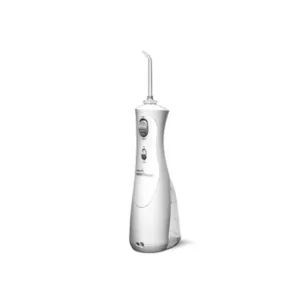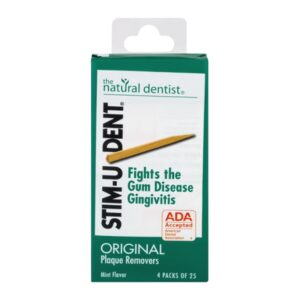Many people prefer doing just about anything rather than flossing their teeth. A survey by the American Academy of Periodontology found that more than a third of people surveyed would rather be doing unpleasant chores like cleaning toilets instead of flossing, 9% would rather be stuck in gridlock traffic for an hour, and 7% would rather listen to small children crying on an airplane. If the thought of flossing your teeth makes you cringe, it’s time to change up your routine and discover new products and techniques that can help make flossing much easier.
Although many adults tend to ignore flossing, it’s actually an essential part of taking care of your teeth and gums, according to the American Dental Association (ADA). So how does flossing work? The action of cleaning between your teeth helps remove a sticky film called plaque, which contains bacteria that love feeding on any leftover food or sugar in your mouth. When this happens, it releases an acid that eats away at the outer shell of your teeth and causes cavities. This sticky goop can also collect below your gum line and eventually harden into tartar. If the bacteria cause inflammation, well, that’s periodontal disease. Left untreated, it can lead to receding gums, tooth decay and even tooth loss! Periodontal disease is unfortunately very common, and by some estimates nearly 1 in 2 Americans suffer from unhealthy gum tissue.
Waterpik® Water Flossers
Perhaps using string isn’t your thing. If so, consider Waterpik’s Water Flosser to blast away gunk and grime between your teeth. This method is clinically proven to improve oral health and offers a popular alternative to running wax nylon between each tooth. Using a powerful blast of water helps clean hard to reach areas in your mouth and is an especially convenient option for cleaning braces and orthodontics, treating periodontal pockets, and cleaning implants and dental work such as crowns, bridges, and veneers. Using any method is still better than nothing! Also keep in mind that some people find water flossers to be too noisy for their tastes and occasionally leaks do happen.
Philips Sonicare AirFloss
The Philips Sonicare AirFloss uses a mixture of both air and water to blast away plaque in those hard to reach places. You simply fill the device with water or mouthwash, aim the nozzle between your teeth, and fire away for about a minute. Many inconsistent flossers who tried this device reported it was easy to use and 96% continued to use the AirFloss four or more days per week. Various settings allow users to control the spray amount, so you can easily customize your experience. As with the WaterPik, some users find the string-less method to be too loud or messy. These devices can also be far more expensive versus purchasing a package of string floss or plaque removing picks, so if budget is an issue, you may want to consider other products.
Stim-U-Dent Plaque Removers
Stim-U-Dent Plaque Removers are soft, flexible wooden cleaners shaped to clean spaces between teeth and stimulate your gums. Just like good old string flossing, we recommend using daily, especially after eating. Stim-u dent can be used as an alternative or supplement to daily flossing. To use, simply apply a gentle in and out motion between your teeth. Most dental picks will run you anywhere from $3 to $7 at popular retailers, so they’re a great option to stock up at home and take with you on the go.
Motivate Yourself to Floss More Often
Maybe finding the right product isn’t your problem and it’s simply about finding the right motivation. To help make flossing a regular routine you need two important things: a simple and obvious cue, and a clearly defined reward. The problem with flossing is there is no instant gratification like we experience when brushing our teeth (tingly minty sensation). There’s no clearly defined reward so it’s easy to think it’s not working. So here’s how to trick your brain into making it an effortless routine that you perform on autopilot thanks to Ask The Dentist Dr. Mark Burhenne:
Create a cue by taking a blank post-it note and sticking it on your bathroom mirror. Avoid writing authoritarian things like “floss” on it and instead just keep it blank to serve as a reminder. Make it fun by using different colors. Now, each time you brush your teeth, you’ll see a post-it note stuck on your mirror and you’ll know it means it’s time to floss.
Make it easy. Keep whichever flossing method you choose stashed in multiple locations. The samples of floss you get after a cleaning are great for this, just keep one in your desk drawer at work, one in your gym bag, and another in the car, in your laptop bag, or your purse. The more convenient, the better. We might not think of flossing late at night before bed because we’re tired, but the thought could come to you during the day, perhaps even before a meeting in order to avoid an errant piece of spinach stuck between your teeth.
Lastly, don’t be hard on yourself. Don’t start off by trying to floss every day. Ease into your new healthy habit by just flossing once a week. Before long, you’ll start to notice the reward of your gums feeling better after flossing and you might decide to floss a few more times each week. Eventually, this method can help you work your way up to flossing every day.
Regardless of the flossing method or habit forming technique you choose, remember the most important thing about cleaning between your teeth is to just do it. If it’s once a month, your teeth and gums are still better off than never flossing at all. Honesty is the best policy when it comes to flossing (or not flossing) and it’s always a good idea to simply tell your dentist and hygienist you’re having a hard time flossing consistently. We love to offer advice and will never guilt or shame you into flossing. We’re in this together and we understand flossing is not always convenient, but it’s still incredibly important for your health. Let’s work together to help find the right solution for you and your teeth!

